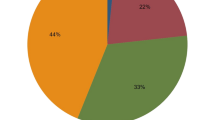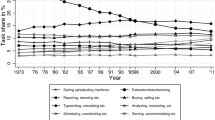Abstract
This paper examines the extent to which children enter into occupations that are different from their father’s occupation, but require similar skills, which we call task following. We consider the possibility that fathers are able to transfer task-specific human capital either through investments or genetic endowments to their children. We show that there is indeed substantial task following, beyond occupational following and that task following is associated with a wage premium of around 5% over otherwise identical workers employed in a job with the same primary task. The size of the premium is similar in magnitude to the size of the premium associated with occupational following. The wage premium is robust to controls for industry, occupation categories and occupation characteristics.
Similar content being viewed by others
Notes
Specifically, we use David Dorn’s classification system based on the 1990 OCCs (occ1990dd) which enables us to unify occupation codes used across different years of GSS data and map these to occupation codes DOT and ONET database use. These occupational codes were downloaded from David Dorn’s website http://www.cemfi.es/~dorn/data.htm on Sep. 24, 2015.
While our preferred approach is to focus on the primary task, our main results are robust to calculating the task following measure as a distance between all tasks as in Okumura and Usui (2016).
While we treat the intergenerational transfer of task-specific human capital as exogenous, the qualitative results are similar in a set-up where father’s choose how much human capital to transfer where the transfer is costly.
PRR = Pr[γϵN − ϵR < HR] =\( =\Pr \left[\frac{u}{\sigma_u}<\frac{H_R}{\sigma_u}\right]=\Phi \left(\frac{H_R}{\sigma_u}\right) \) where u=−v = γϵN − ϵR and \( {\sigma}_u={\left[1+{\gamma}^2-2\rho \gamma \right]}^{\frac{1}{2}} \).
The wage premium to R-task following is: PremiumR = E(wRR) − E(wNR) =HR + E[ϵR| u < HR] − E[ϵR|u < − γHN] \( ={H}_R+\frac{\gamma \rho -1}{{\left[1+{\gamma}^2-2\rho \gamma \right]}^{\frac{1}{2}}\ }\left[\lambda \left(-{\delta}_N\right)-\lambda \left(-{\delta}_R\right)\right] \) where δN and δR are defined as above and ρRu is the correlation between u and ϵR.
Employed is defined as having a working status is “Working full time”, “Working part-time”, and “With a job, but not at work because of temp illness, vacation and strikes”. We do not consider individuals whose working status are “Unemployed or laid off”, “Retired”, “In School”, and “Keeping house”. We also excluded individuals who are 1) current armed-forces, 2) former armed forces with no valid occupational codes, 3) self-employed.
Specifically, we used the crosswalks provided by Dorn (2009) and Autor and Dorn (2013), giving 3-digit occupation codes—or occ1990dd—that can serve as a link between occupation codes of 1970, 1980, 1990, and 2000 census. We first use their crosswalk linking 1970 and 1990dd and then the crosswalk linking 2000 and 1990dd, so that all occupations in our sample will be measured by 1990dd codes in a consistent fashion. In the mapping of occ1970 to occ1990dd, two occupations that could not be directly mapped. One of them is occupation “280” from occ1970 “sales and salesmen clerk” (884 respondents in the sample). We assign occ1990dd code 274 to this occupation, guided by the occupation definitions contained in Meyer and Osborne (2005) and in Dorn (2009). Another occupation with occ70 coded as 590 in GSS data, containing 165 observations in fathers’ data and 191 observations in individuals’ data. Since the code cannot be found in census 1970 codes, (https://usa.ipums.org/usa/volii/97occup.shtml), it is left un-coded in occ1990dd. All the occ80 codes are matched to occ1990dd expect for current and former arm-forces. Details of the procedure are available upon request.
The Department of Labor’s Dictionary of Occupational Titles (DOT) is originally used by Autor et al. (2003) to impute to workers the task measures associated with their occupations, and then it is also verified and merged with Occupational Information Network (O* Net), Census and CPS occupational categories.
There are 4 occupations have no task measurements in Autor et al. (2003), and they are: 1) occ1990dd = 227, occ80 = 227: “Air traffic Controllers and Airfield Operations Specialists”. 2) Occ1990dd = 303, occ1980 = 303: “First-Line Supervisors/Managers of Office and Administrative Support”. 3) Occ1990dd = 503, occ1980 = 503: “First-Line Supervisors/Managers of Mechanics, Installers, and Repairers”. 4) Occ1990dd = 803, occ1980 = 803: “Supervisors, Transportation and Material Moving Workers”. Given that these occupations accounts for a small proportion in sample (less than 100 observations), we do not include these observations in the analysis.
See definitions for particular skills in the Appendix.
Given that the number of years of education is partially determined by the choice of occupation, Okumura and Usui (2016) do not use this in their main wage specification. We include this to be consistent with the occupational following literature and explore its exclusion in a robustness check.
Estimates using the Okumura and Usui (2016) measure of task correlation are available upon request.
References
Acemoglu D, Autor D (2011) Skills, tasks and technologies: implications for employment and earnings. Handbook Labor Econ 4:1043–1171
Aina C, Nicoletti C (2014) The intergenerational transmission of Liberal professions: nepotism versus abilities. Univ York Discus Papers Econ 14
Altonji JG, Dunn TA (2000) An intergenerational model of wages, hours, and earnings. J Hum Resour:221–258
Autor DH, Dorn D (2013) The Growth of Low-Skill Service Jobs and the Polarization of the US Labor Market. Am Econ Rev 103(5):1553–97
Autor DH, Levy F, Murnane RJ (2003) The skill content of recent technological change: an empirical exploration. Q J Econ 118(4):1279–1333
Autor, D. H., Katz, L. F., Kearney, M. S. (2006). The polarization of the US labor market. Am Econ Rev 96(2):189–194
Blau, P. M., and Duncan, O. D. (1967). The American occupational structure. The american occupational structure. John Wiley and Sons: New York.
Dorn D (2009) This job is "getting old": measuring changes in job opportunities using occupational age structure. Am Econ Rev 99(2):45–51
Escriche L (2007) Persistence of occupational segregation: the role of the intergenerational transmission of preferences. Econ J 117:837–857
Feinstein BD (2010) The dynasty advantage: family ties in congressional elections. Legis Stud Q 35(4):571–598
Groothuis PA, Groothuis JD (2007) Nepotism or family tradition? A study of NASCAR drivers. J Sports Econ 9(3):250–265
Ham R, Junankar PN, Wells R (2009). Occupational Choice: Personality Matters. IZA Discussion Papers. DP No. 4105
Hellerstein JK, Morrill MS (2011) Dads and daughters. J Hum Resour 46(2):333–372
Knoll B, Riedel N, Schlenker E (2017) He's a Chip off the old block-the persistence of occupational choices across generations. Labour 31(2):174–203
Laband DN, Lentz BF (1983a) Like father, like son: toward an economic theory of occupational following. South Econ J:474–493
Laband DN, Lentz BF (1983b) Occupational inheritance in agriculture. Am J Agric Econ 65(2):311–314
Laband DN, Lentz BF (1992) Self-recruitment in the legal profession. J Labor Econ:182–201
Lentz BF, Laband DN (1989) Why so many children of doctors become doctors: nepotism vs. human capital transfers. J Hum Resour:396–413
Lentz BF, Laband DN (1990) Entrepreneurial success and occupational inheritance among proprietors. Can J Econ:563–579
Meyer, P. B., and Osborne, A. M. (2005). Proposed Category System for 1960–2000 Census Occupations (p. 383). Washington, DC: US Department of Labor, Bureau of Labor Statistics, Office of Productivity and Technology
Okumura T, Usui E (2014) Do parents’ social skills influence their Children’s sociability? BE J Econ Anal Policy 14(3):1081–1116
Okumura T, Usui E (2016) Intergenerational transmission of skills and differences in labor market outcomes for blacks and whites. Res Labor Econ 43:227–286
Pinchot S, Lewis BJ, Weber SM, Rikkers LF, Chen H (2008) Are surgical progeny more likely to pursue a surgical career? J Surg Res 147(2):253–259
Rogoff N (1953) Recent trends in occupational mobility. Ill: Free Press, Glencoe
Scoppa V (2009) Intergenerational transfers of public sector jobs: a shred of evidence on nepotism. Public Choice 141(1–2):167–188
Author information
Authors and Affiliations
Corresponding author
Ethics declarations
Conflict of Interest
Authors have no conflict of interest to declare.
Additional information
Publisher’s Note
Springer Nature remains neutral with regard to jurisdictional claims in published maps and institutional affiliations.
Appendix
Appendix
Task Measures
Following Autor et al. (2006) and Acemoglu and Autor (2011), the tasks and skills in the work activities are defined as follows:
Non-routine cognitive: Analytical
Analyzing data/information.
Thinking creatively.
Interpreting information for others.
Examples of jobs with intensive non-routine cognitive analytical tasks: actuaries, physicists and astronomers, economists, market researcher and survey researcher
Non-routine cognitive: Interpersonal
Establishing and maintaining personal relationships.
Guiding, directing and motivating subordinates.
Coaching/Developing others.
Examples of jobs with intensive non-routine cognitive interpersonal tasks: clergy and religious workers, athletes, sports instructors, and officials
Routine cognitive
Importance of repeating the same task.
Importance of being exact or accurate.
Structured v. Unstructured work (reverse).
Examples of jobs with intensive routine cognitive tasks: telephone operators, transportation ticket and reservation agents, and cashiers
Routine manual
Pace determined by speed of equipment.
Controlling machines and processes.
Spend time making repetitive motions.
Examples of jobs with intensive routine manual tasks: machine operators, winding and twisting textile/apparel operatives, crane, derrick, winch and hoist operators
Non-routine manual physical
Operating vehicles, mechanized devices, or equipment.
Spend time using hands to handle, control or feel objects, tools, or controls.
Manual dexterity.
Spatial orientation.
Examples of jobs with intensive non-routine manual physical tasks: airplane pilots and navigators, excavating and loading machine operators, millwrights, taxi drivers and chauffeurs
Non-routine manual interpersonal
Performing for or working directly with the public.
Provide consultation and advice to others.
Examples of jobs with intensive non-routine manual interpersonal tasks: psychologists, managers of food-serving and lodging establishments, actors, directors and producers.
We further utilized Autor and Dorn’s aggregation to group all occupations to the 1-digit level as follows:
management/professional/technical/financial/sales/public security,
administrative support and retail sales,
low-skill service,
precision production and craft, machine operators, assemblers and inspectors
transportation/construction/mechanics-/mining/agricultural.
Rights and permissions
About this article
Cite this article
Chen, L., Gordanier, J. & Ozturk, O. Task Followers and Labor Market Outcomes. J Labor Res 40, 181–201 (2019). https://doi.org/10.1007/s12122-019-9282-6
Published:
Issue Date:
DOI: https://doi.org/10.1007/s12122-019-9282-6




